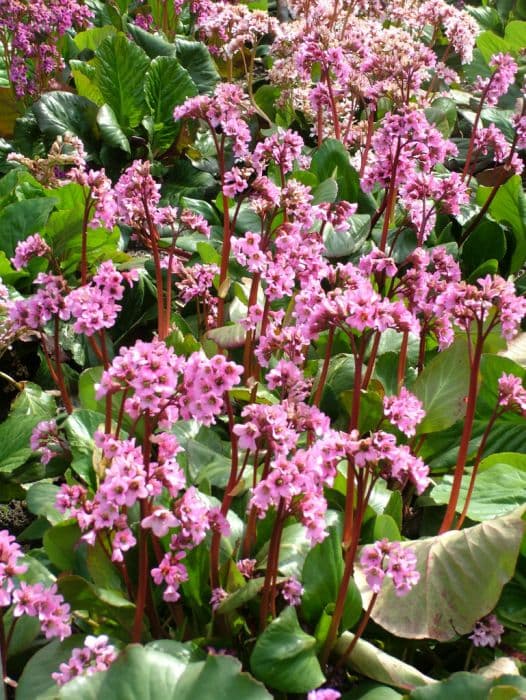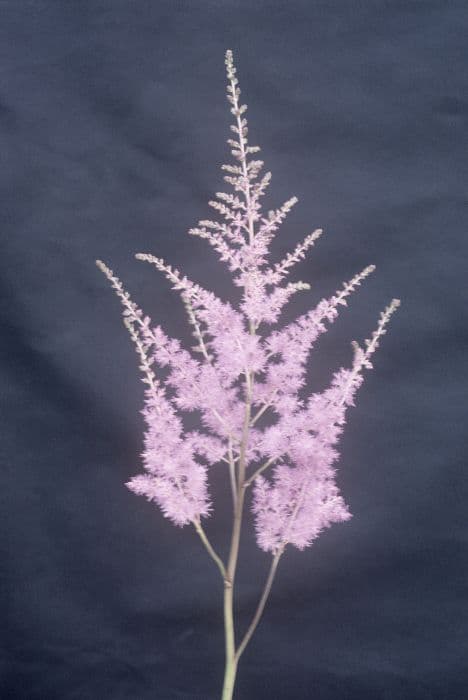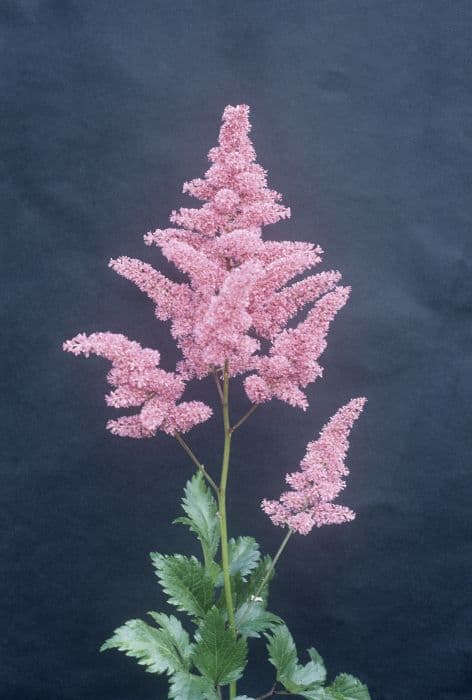Pigsqueak Bergenia 'Rosi Klose'

ABOUT
Bergenia 'Rosi Klose', often known simply as Bergenia, is a perennial plant recognized for its robust and leathery leaves that have a rounded heart shape. These leaves often have a glossy surface and can change color throughout the seasons, displaying hues of green, bronze, and sometimes reddish tones, especially during the cooler months. The plant produces striking flower stalks that bear clusters of bell-shaped flowers in various shades of pink. These blossoms are typically vibrant and can add a splash of color to the landscape. The overall impression of Bergenia 'Rosi Klose' is one of a sturdy and attractive plant that offers both foliage interest and floral beauty.
About this plant
 Names
NamesFamily
Saxifragaceae
Synonyms
Pigsqueak, Elephant's Ears, Leather Bergenia, Heartleaf Bergenia, Megasea
Common names
Bergenia 'Rosi Klose'.
 Toxicity
ToxicityTo humans
Bergenia 'Rosi Klose', commonly known as Bergenia, generally is not considered toxic to humans. There are no well-documented cases of poisoning from ingesting Bergenia, and it is not typically listed among plants that pose a risk of serious harm if consumed. However, it's important to note that eating any non-food plant material can cause gastrointestinal discomfort or irritation for some individuals, so it is advisable to avoid ingesting parts of the plant.
To pets
Bergenia 'Rosi Klose', commonly referred to as Bergenia, is not known to be toxic to pets such as dogs and cats. Similar to humans, there are no significant risks of poisoning reported from pets ingesting this plant. Nonetheless, ingestion of plant material could potentially lead to mild gastrointestinal upset in some pets, so it is wise to monitor your pet and keep non-food plants out of their reach when possible.
 Characteristics
CharacteristicsLife cycle
Perennials
Foliage type
Evergreen
Color of leaves
Green
Flower color
Pink
Height
1 foot (0.3 meters)
Spread
1 foot (0.3 meters)
Plant type
Herb
Hardiness zones
3
Native area
Asia
Benefits
 General Benefits
General Benefits- Low Maintenance: Bergenia 'Rosi Klose' is a hardy plant that doesn't require frequent care or complex gardening skills, making it suitable for both beginners and experienced gardeners.
- Ground Cover: Its broad leaves and clumping habit make it an excellent choice for ground cover, helping to suppress weeds and reduce soil erosion.
- All Season Interest: The plant has evergreen foliage, which provides visual interest throughout all the seasons, including winter when many other plants have died back.
- Drought Tolerance: Once established, Bergenia 'Rosi Klose' can tolerate periods of drought, making it ideal for gardens in drier climates or for gardeners seeking water-wise plants.
- Attracts Pollinators: The flowers of Bergenia 'Rosi Klose' attract bees and butterflies, aiding in the pollination of your garden.
- Colorful Blooms: It produces vibrant pink flowers in the spring, which add a splash of color to the garden and can be used in cut flower arrangements.
- Versatile Planting Options: This plant is suitable for planting in borders, rockeries, and containers, offering flexibility in garden design.
- Frost Resistance: Bergenia 'Rosi Klose' is capable of withstanding cold temperatures and can survive frost, making it suitable for cooler climates.
 Medical Properties
Medical PropertiesThis plant is not used for medical purposes.
 Air-purifying Qualities
Air-purifying QualitiesThis plant is not specifically known for air purifying qualities.
 Other Uses
Other Uses- Bergenia 'Rosi Klose' leaves can be pressed and used in botanical art projects due to their relatively large size and interesting texture.
- The roots can be used as a natural dye for fabrics and yarns, producing colors that range from pale yellow to deep rust, depending on the mordant used.
- These plants make effective ground cover in landscaping, reducing soil erosion on slopes or in areas prone to being bare.
- The thick leaves are sometimes used in garden arrangements for their evergreen presence, making them useful in winter gardens.
- Bergenia 'Rosi Klose' can serve as a living mulch, retaining moisture in the soil and suppressing weed growth with its dense foliage.
- In areas where it is hardy, Bergenia 'Rosi Klose' can edge pathways, providing a tidy, uniform appearance year-round.
- The leathery leaves can lend a tropical look to temperate gardens, providing a unique texture contrast when used in mixed borders.
- Their resilience to trampling makes them suitable as fillers between stepping stones, where few other plants would survive.
- Bergenia 'Rosi Klose' is ideal for rock gardens because of its preference for well-drained soil and its ability to withstand the cold.
- The plant can be grown in large containers, where it can add architectural interest to patios, balconies, and other outdoor living spaces.
Interesting Facts
 Feng Shui
Feng ShuiThe Bergenia is not used in Feng Shui practice.
 Zodiac Sign Compitability
Zodiac Sign CompitabilityThe Bergenia is not used in astrology practice.
 Plant Symbolism
Plant Symbolism- Tenacity: The Bergenia plant, often known as "Pigsqueak" because of the sound its leaves make when rubbed together, typically symbolizes tenacity due to its hardy nature and ability to withstand harsh conditions.
- Protection: With its substantial, leathery leaves, Pigsqueak may be considered to embody protective qualities, offering a shield-like representation.
- Endurance: Pigsqueak's evergreen leaves that persist through winter can signify endurance or perseverance, as the plant endures and thrives despite the cold.
- Adaptability: Given its ability to adapt to a variety of environments, Pigsqueak can be seen as a symbol of adaptability and versatility.
- Healing: Historically, some cultures have used Bergenia for medicinal purposes, which can give it a symbolic association with healing and wellness.
 Water
WaterPigsqueak should be watered deeply but infrequently, aiming for about 1 inch of water per week, whether from rainfall or manual watering. It's best to water this plant when the top few inches of soil feel dry to the touch. A thorough soaking helps to encourage deeper root growth, leading to a more drought-tolerant plant. During the hot summer months, you may need to water more often, especially if you notice the leaves wilting. In contrast, during the winter when the plant is dormant, reduce the water you provide.
 Light
LightPigsqueak thrives in partial shade to full shade conditions. It can tolerate some morning sun, but too much direct sunlight can scorch the leaves. The ideal spot for this plant would be under the canopy of larger trees or on the north side of a building where it receives filtered light or only a few hours of direct sunlight.
 Temperature
TemperaturePigsqueak is a hardy plant that can tolerate a wide range of temperatures, typically thriving between 60°F and 75°F. It is most comfortable in cooler conditions and can survive minimum temperatures as low as 0°F. However, to maintain good health and abundant blooms, avoid exposing Pigsqueak to prolonged periods of extreme heat above 80°F.
 Pruning
PruningPigsqueak should be pruned to remove spent flower stalks after blooming to encourage a tidy appearance and possibly a second bloom. Prune away any damaged or withered leaves in early spring to make room for new growth. The best time for more extensive pruning is late winter or early spring, before new growth begins.
 Cleaning
CleaningAs needed
 Soil
SoilElephant's Ears prefer moist, well-draining soil with a pH range of 5.5 to 7.5. A mix with organic matter such as leaf mold or compost will provide the nutrients these plants need.
 Repotting
RepottingElephant's Ears do not need frequent repotting. Repotting every 3-4 years or when the plant outgrows its container is advisable.
 Humidity & Misting
Humidity & MistingElephant's Ears thrive in average to high humidity levels, but they are adaptable to a range of indoor humidity conditions.
 Suitable locations
Suitable locationsIndoor
Place Elephant's Ears in bright, indirect light and keep the soil consistently moist.
Outdoor
Plant Elephant's Ears in partial shade and provide ample water during dry spells.
Hardiness zone
3-8 USDA
 Life cycle
Life cycleThe life of Bergenia 'Rosi Klose', commonly known as Heartleaf Bergenia or Pigsqueak due to the sound its leaves make when rubbed, begins with germination from the seed under optimal conditions of moist, well-draining soil and partial to full shade. Following germination, the seedling grows into a rosette-forming perennial, developing thick, leathery leaves that persist throughout the year. As it matures, it produces robust flower stalks with clusters of deep pink blossoms, typically in early to mid-spring. After pollination, which is assisted by insects such as bees, it sets seed which can be dispersed to form new plants. With the approach of autumn, while the leaves may darken, the plant remains evergreen, persisting through the winter months. Over the years, the clumps of Bergenia 'Rosi Klose' may expand through vegetative reproduction, with offshoots forming at the base of the parent plant, gradually leading to a larger colony of plants.
 Propogation
PropogationPropogation time
Spring to Summer
The Bergenia 'Rosi Klose', commonly known as the heartleaf bergenia, is typically propagated by division. This is the most popular method and is best done in the spring or early fall. To propagate by division, carefully dig up the parent plant and gently tease apart the clumps into smaller sections, each with a portion of the root system and several shoots. These divisions should then be replanted at the same soil depth they were growing at originally, spaced about 12 inches (approximately 30 centimeters) apart to allow room for growth. Water the newly planted divisions well to help establish them. Division not only helps to propagate new plants but also rejuvenates old clumps that may have become woody or less vigorous with time.









